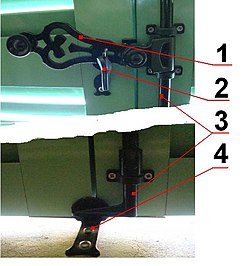
An espagnolette is a locking device, normally mounted on the vertical frame of a French door or casement window. A handle or knob is connected to a metal rod mounted to the surface of the frame, about a metre above the floor. Operating the handle rotates the rod, which has hooks at each end that fit into sockets at the head and sill of the opening. [1] This type of lock is often used on semi-trailer trucks with dry van and reefer semi-trailers to fasten the rear doors as well as in intermodal containers. It can be identified by the use of a round bar, instead of a half-round bar used on a crémone bolt.
Contents
The espagnolette mechanism consists of a vertical rotating rod (3) that is mounted using sleeves onto the inner face of the window sash (traditionally on the rebate or strike edge). The rod is centrally connected to a decorative lever arm (1), also known as a paddle or handle, which is hinged and rotates outward from a metal keeper bracket (2). When pulled, this action rotates the rod, which engages or disengages forged hook-shaped ends at the top and bottom. These hooks catch behind metal pins (called "stops" or "studs") mounted on the frame — one of which is visible at the floor (4). In the closed position, the handle may also latch into a fixed frame-mounted hook, ensuring secure locking. This setup allows tall sashes to be locked at both ends simultaneously. [2]




